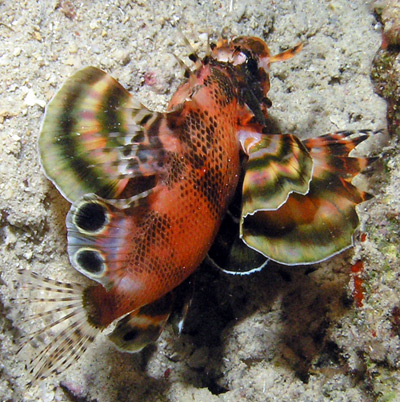Yearn to keep a lionfish but don’t think you have the tank space to accommodate one? You might want to think again! While having a small to medium-sized tank might preclude keeping some of the popular Pterois species, there are several lionfish species in the genus Dendrochirus that are small and retiring enough to be kept successfully in fairly modest-sized quarters. Among these is the subject of today’s post: D. biocellatus, the Fu Manchu lionfish, also known as the twinspot lionfish, ocellated lionfish, or twospot turkeyfish.
In terms of its ease of care, I would characterize D. biocellatus species as moderately difficult. So, it’s not a great choice for beginners, but if you have a few years of successful fishkeeping experience under your belt and are willing to give it the specialized care it requires, you won’t be disappointed!
Physical traits
D. biocellatus reaches only about 5 inches in total length and is mottled with various shades of orange, brown, black, and white. Its pectoral fins are large and fan-like, and it sports two prominent ocelli, or eyespots, on the posterior of the dorsal fin. This species’ other notable feature are the two elongated appendages extending from the corners of the mouth, somewhat resembling a long, droopy moustache—thus the “Fu Manchu” appellation.
Small but still venomous!
Despite being quite diminutive as lionfish go, D. biocellatus still possesses venomous dorsal spines that can deliver a severe sting to unwary aquarists. So, don’t assume you can let down your guard when transferring these little lions or working in a tank containing one.
Feeding
This is where the “potentially picky” part comes in. One of the chief frustrations among hobbyists who keep this species is that it can be very difficult to get it to accept standard aquarium fare. In nature, D. biocellatus feeds primarily on small fish and crustaceans, and in many instances, captive specimens resist making the switch to non-living fare for prolonged periods. In these situations, items such as live ghost shrimp may be necessary to initiate a feeding response. Some specimens simply refuse to eat altogether, so it’s important to see a potential purchase fed before you acquire it.
With patience and persistence, though, it’s often possible to train these little lions to accept non-living meaty items, such as shrimp, silversides, clam meat, and the like. The best way to achieve this is to present the item on a feeding stick or section of rigid airline tubing and give it a little jiggle so it appears lifelike.
Housing
Because this species is small, very shy, secretive, and typically found resting on or hopping/scooting/fluttering around the rockwork, it doesn’t demand much in the way of open swimming space. It does, however, need lots of caves and hidey holes in which to refuge, so the aquarium should be large enough to allow appropriate aquascaping. I would consider 30 gallons a good minimum tank size.
Compatibility
You have to strike a delicate balance in choosing tankmates for D. biocellatus. On the one hand, you have to be careful to avoid aggressive predators and species prone to nipping fins/appendages, as either type of tankmate will stress the lion, outcompete it at feeding time, and likely keep it in hiding. On the other hand, you have to avoid introducing any fish small enough to be perceived as potential prey by this stealthy hunter. Also, conspecifics will often squabble, so it’s best to keep this species one to a tank. Apart from those considerations, any peaceful, keep-to-themselves species that are at least as large as the lion should be acceptable as tankmates.
D. biocellatus can be considered reef safe, as it will not nip at or consume sessile invertebrates. However, keep in mind that ornamental crustaceans will not be safe, and specimens may come to rest upon corals, potentially irritating them and causing them to remain in a contracted state.



